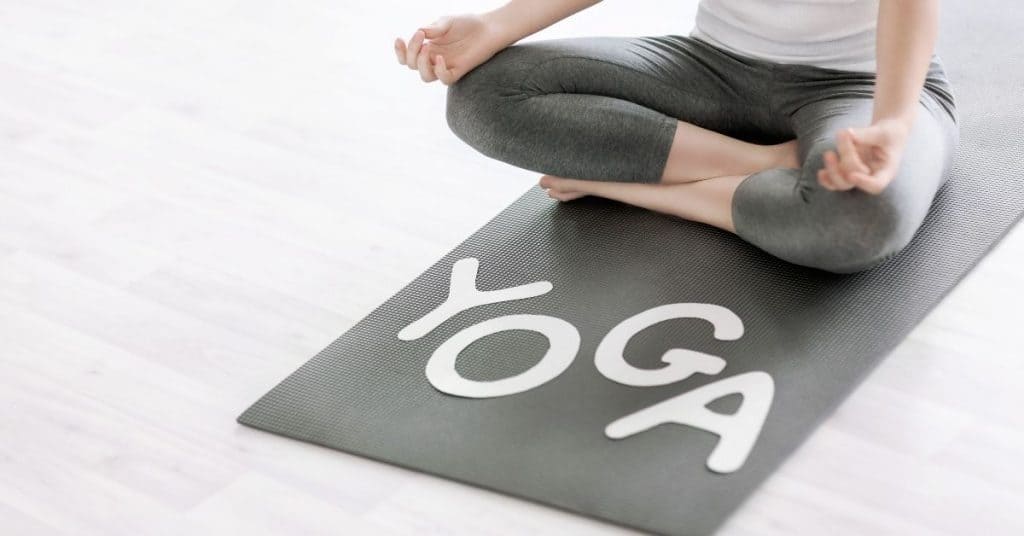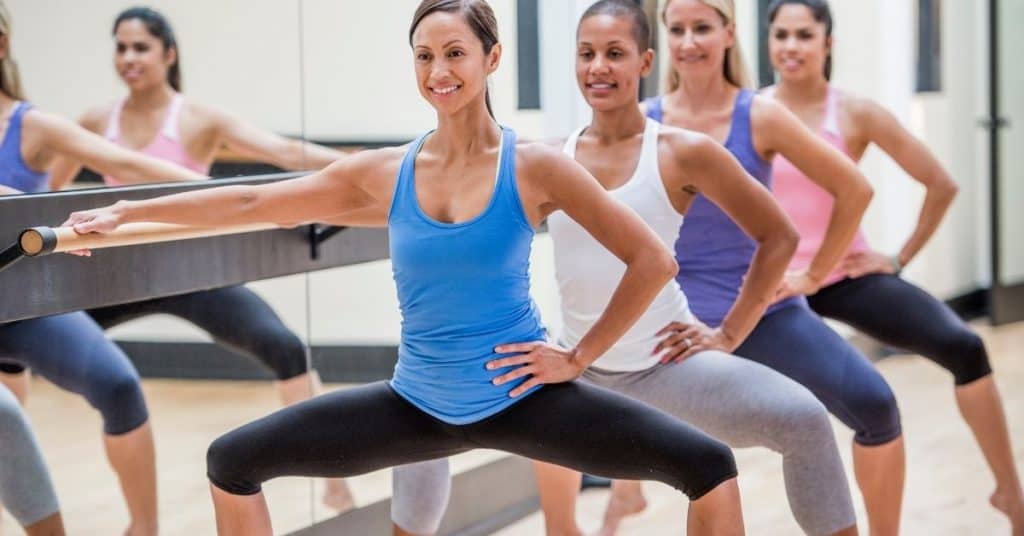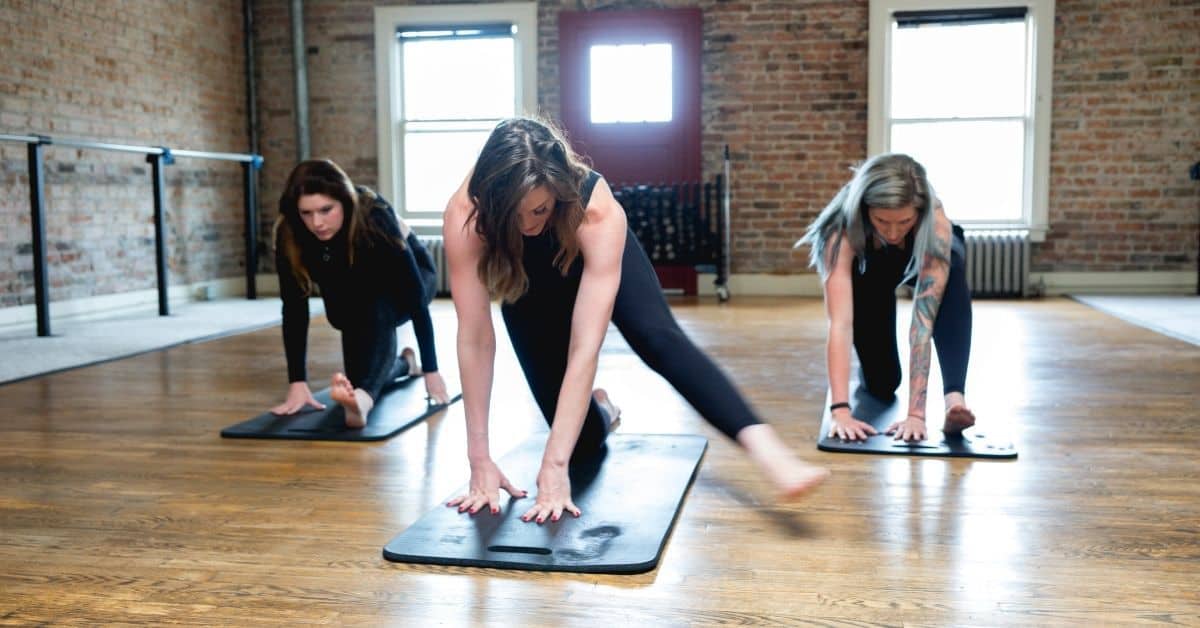The fitness world has evolved a great deal over the years. We now have many fitness routines and classes, all promising great benefits. Yoga is one of the most popular, and barre has also grown in popularity in recent times, but while these two types of exercise have some similarities, they are also fundamentally different.
Yoga is a type of exercise that helps the body achieve better flexibility while also tuning the mind to achieve inner calm. Barre, on the other hand, is a form of fitness that draws inspiration from ballet. It’s aimed at toning the body, burning fat, and improving cardiovascular health.
The rest of this article will take a closer look at yoga and barre, covering everything you need to know about how both of them can help your mind and body, the differences between them, and how to choose between them—if you have to.
What Is Yoga?

Yoga is a mind-body exercise with roots in ancient India, dating back thousands of years. It incorporates the execution of different poses. Enthusiasts love yoga because it focuses on creating balance in your body and your mind. By practicing yoga, you’ll also be able to strike a balance between breathing and movement. There are many types of yoga in practice today. Some of those you’re likely to encounter in your local class include the following:
- Anusara – Anusara is a physically and mentally challenging yoga approach that combines postures with the Anusara philosophy. The term Anusara means “flowing with grace.”
- Ashtanga – Ashtanga is another physically tasking yoga approach that involves repeating a specific set of postures while maintaining specified breath movements. As a beginner, you most likely won’t start with Ashtanga except under strict supervision from an experienced instructor.
- Bikram – Also known as heated yoga, Bikram is another challenging yoga practice spread across 90 minutes in a room with temperatures between 95-105°F (35-40°C). Adherents love this type of yoga because of the supposed weight-loss benefits. Again, this is another approach that can be very tasking for beginners, but some instructors can make it less daunting.

- Hatha – Hatha is a collective term that refers to all the various yoga types typically taught in studios across the west. However, some studios have specific classes that they refer to as Hatha, which are typically slower-paced, introduction to postures—making them beginner-friendly.
- Vinyasa – Vinyasa is another challenging form of yoga, where breathing is intertwined with various poses. It’s also known as flow yoga because the poses are connected in a seamless flowing movement—from forward bend to chaturanga and upward dog to downward dog. The sessions for a Vinyasa are typically categorized in levels, starting from beginner to advanced.
- Power Yoga – This type of yoga is similar to Vinyasa, but here, there’s no flowing through different forms of poses. You’ll hold one pose for a longer period.
- Iyengar – Iyengar is a yoga approach where the emphasis is placed on the minutest alignment points. It’s great for beginners because poses are held for longer, and the overall pace is slower.
- Yin or Restorative Yoga – Yin is a relaxing yoga class with an emphasis on meditation. It mostly involves holding reclined postures for prolonged periods.
- Kundalini – Kundalini is a popular yoga method that combines postures, mediation, chanting, and breathing exercises to wake up the “kundalini energy” and enhance awareness.
As a beginner, the various types of yoga may feel overwhelming. You may be at a loss on where to start. However, the best bet is to check out beginner classes near you to see what is available.
After you’ve learned the major foundational postures, you can proceed to advanced classes and then start trying different combinations to see what works for you—in line with your unique goals. Many yogis generally maintain a single approach, but there’s no limit on how many approaches you can embrace.
Ashtanga and Bikram are favorites for people looking to improve core strength and burn fat. If you’re looking for a more philosophical approach that incorporates meditation, you should look at Ansara and Kundalini.
What Are the Benefits of Yoga?
There are many benefits of yoga. Some of them are covered below:
- Encourages healthy bones and joints. Yoga puts your joints through a full range of motion. Therefore, it encourages healthier joints overall and also ensures a healthier connective tissue. This can help improve your flexibility and mobility. The weight-bearing nature of most yoga poses also encourages better bone density.
- Improves core strength and overall body composition. Yoga’s ability to build strength is one of its main benefits. Some research shows that it can help develop muscle mass, making it a possible weight loss solution.
- Improves mental health. Yoga is good for mental health. Research has shown that it can relieve anxiety, depression, and stress. Regular practice can also lead to significant improvements in the quality of your sleep.
- Helps in pain relief. If you’re one of the many people that miss work because of back pain, you may find yoga very helpful as it can alleviate lower back pain, as well as headaches and neck pain.
- Improves cognitive and physical balance. Yoga can improve balance by strengthening the ankles and the feet, as well as enhancing proprioception. The balance also extends to the cognitive functions as yoga’s impact on the mind translates to a kind of leash on age-related cognitive decline.

Who Should Practice Yoga?
There’s no limit on who can enjoy the overall benefits of yoga, regardless of age, level, and gender. You don’t need to be an ardent yogi to reap some of the benefits, either.
Spending an hour a week on your chosen yoga practices can help you become more flexible, develop better core strength, and develop a better body shape overall.
Can You Practice Yoga Alone at Home?
You can practice yoga at home, but as a beginner, it’s best to start with a seasoned instructor either in their studio (alongside other people) or in a private arrangement. This is the best way to be sure you’re practicing your yoga exercises correctly and safely. As the classes go on, you’ll receive home exercises you can safely practice on your own and work your way up from there.
The best yoga instructors have at least a 200-hour teaching certificate from Yoga Alliance. You should also talk to your doctor if you have any outstanding medical issues to confirm that Yoga will be safe for you.
What Are the Downsides to Yoga?
Yoga may have a lot of benefits, but there are a few potential downsides you should keep in mind:
- Headstands encouraged in different yoga routines may cause glaucoma. The evidence to support this is, however, still lacking.
- Bikram Yoga or Hot Yoga may not be safe for everyone. There are arguments for and against it, so you’re probably better off avoiding it and sticking to other forms of yoga.
- Yoga can increase the risk of injuries if it’s not done in moderation. This is especially true if you have the low muscle strength and attempt to engage in some of the demanding physical postures of some yoga routines. Also, extreme movements that can affect your vertebrae may lead to damage to the nervous system. This is why yoga poses should only be undertaken by someone in good health.
- Poses that include supported headstands can cause osteoporosis.
How Long Before You Start to See Results With Yoga?
The length of time depends on your goals. For weight loss and muscle development, you can expect to see noticeable results within a month of engaging in yoga for at least 30 minutes per day. You will also feel stronger if you are trying to improve your core strength. For longer-term benefits, however, you may have to wait a few more months.
What Is Barre?

Barre is a type of exercise that combines ballet, Pilates, and yoga. It was first created by Lotte Berk, a German ballerina, in the 1950s. The exercise’s makeup means that it is great for muscle toning while not quite demanding on the joints as other exercises.
The classes look simple, but the pulsing movements will make you sweat a great deal. The routines finely balance graceful movements with athleticism. In the last few years, we’ve seen a growth in popularity for barre exercise, with lots of classes opening up in various fitness centers across the country.
Barre classes are not as regimented as yoga or Pilates. Therefore, routines are mostly free-form and will vary a great deal from one instructor to another. You’ll use the barre as a balancing prop as you complete repetitions of ballet-related moves and some isometric strength training.
You’ll also need a mat during barre classes. This is to take part in the core exercises, and flexibility training pulled from Pilates and yoga. Other props you might need to increase resistance and make the routine more challenging include resistance bands, balls, small dumbbells, and more.
Cardio segments are set aside during barre workouts to get your heart pumping and to help burn calories. This is why barre classes closely resemble aerobics sessions more than yoga. It is also why people looking to lose weight are often advised to consider going with barre first instead of yoga or Pilates. You can burn up 850 calories per hour during barre classes.
There isn’t a lot of focus on breathing during barre classes. Some instructors may create sessions that include breathing routines, but this is not the norm. You can complete your classes without one of these.
So, you can think of barre as a more upbeat form of exercise that takes most of the best bits of yoga and Pilates, without the physically demanding parts. You’ll sweat a lot and burn calories, but you won’t have to worry about pains in your joints or getting into uncomfortable positions.
What Are the Benefits of Barre?
As we’ve seen above, Barre is an attractive exercise option if you’re looking for a tough workout routine that isn’t too demanding on your body. However, this doesn’t make it any less beneficial than other options. Here are some of the benefits of barre:
- Improves core strength. Barre is highly reliant on balance and control. You’ll have to use your core a great deal, even when you’re targeting other parts of your body with a workout session. After a few weeks of consistency, you’ll begin to see some improvements in your core strength.
- Engages the whole body. Barre is an exercise routine you can count on to work your entire body during a session. This is due to the cardio-leaning components, which involve a lot of standing and movement. It’s why the exercise is encouraged for people looking for improvements in body alignment, flexibility, and posture.
- You don’t need previous experience. Barre is seen as a fitness class designed for dancers and other very physically active individuals in some quarters. However, this isn’t the reality as the exercise option is open to everyone regardless of their fitness levels.
- Improves mind and body connection. If you’re looking for another exercise option that can help your body get in tune with your mind (apart from yoga), you’ll love barre. The routines emphasize grace, posture, body-lengthening, and other elements that are bound to deliver that mind-muscle connection you’re looking for.
Who Should Practice Barre?
As we’ve touched on briefly above, there’s no limit to who can practice barre. The dance elements might be attractive for women, but men will also benefit immensely from the routines. If you love yoga and Pilates, you’re almost guaranteed to love barre.
More intense barre sessions can be super useful if you have a workout goal in mind, such as weight loss, general fitness, injury prevention or recovery, improved body confidence, and general performance. You’ll see physical results over time. Non-physical results like improved confidence and increased body awareness will kick in fairly quickly as well.
Can You Practice Barre Alone at Home?
One of the main benefits of barre workouts is that you can engage in them from the comfort of your home if you don’t want to go to a studio. All you need to do is get some videos from certified instructors and follow their instructions.
To make the sessions feel as realistic and close to the studio experience as possible, you should consider getting some of the main equipment you’ll see in a studio. This includes a yoga mat, weights, resistance bands, a ballet barre, and anything else your instructor recommends.
If you want to get started with the routines first without spending money on equipment, you can make do with household objects. Your soft blanket can work as a yoga mat. A water bottle filled with water can serve as your weight. If you need a bar, you can use a chair as a temporary option.
When looking for barre classes you can take from home; you should focus on options taught by certified instructors. This is to make sure you’re practicing the right techniques and not wasting your time. Free barre workout videos on social media may not be as thorough as paid options that can be personalized with your goals in mind.
What Are the Downsides to Barre?
- Barre is not as challenging as other workout options, but the constant movements may be problematic for people with existing mobility difficulties. However, the flexibility of the programs means that it’s always possible to get a bespoke barre regime that incorporates your health conditions.
- Building functional strength with barre is difficult due to the lack of compound movements such as lunges and squats. This means you may not be able to gain the strength needed for everyday activities such as carrying a bag of groceries or climbing a flight of stairs. Some instructors have, however, started to add this to their routine.
- Your body can easily get used to the sessions, making them ineffective. Therefore, you need to work with an instructor that understands how to keep upping the ante to prevent a peak.
- There’s been very little scientific research into the efficacy of barre. It’s, therefore, hard to know for sure how it can affect the body.
How Long Before You Start to See Results With Barre?
You will start to feel the impact of barre exercises almost immediately, but it’ll likely take a few weeks before you start seeing any physical results. To increase your chances of seeing physical or external benefits from barre, you should maintain the frequency of the classes, increasing the difficulty as your body adapts.
What Are the Differences Between Yoga and Barre?
Different Foundations
Although yoga and barre are similar in many ways, they are different at the foundational level. Barre and some types of yoga may incorporate low-impact movements, but it’s barre that can truly qualify as a workout routine in the real sense.
Yoga is deeply rooted in Hindu theism. The focus is on preparing the body for calm or stillness and getting into meditation. Today, western yoga instructors lump it together with other forms of exercise, but that doesn’t make it true. Even with the physically demanding types of yoga, the workout factor remains low.
Range of Styles
Modern yoga comes in a wide range of styles ranging from Ashtanga to Vinyasa and more. This makes it easy for prospective yogis to choose a style that best aligns with their goal.
On the other hand, barre doesn’t have a standardized number of styles, leaving instructors to craft routines as they see fit. This means that while barre is supposed to be more of a workout than yoga, some yoga types can end up being more strength-building and sweat-inducing than a typical barre session.
Range of Movement and Breath Work
Barre classes rarely incorporate breath work and will only briefly stretch muscle groups. On the other hand, yoga typically involves more breath routines and a lot more movements aimed at improving flexibility.
Music Accompaniment
The music in a barre class is generally more upbeat and motivating compared to the calm and peaceful options used in different types of yoga.
Equipment Required
In yoga, you mostly need a mat to complete routines. Barre classes also require a mat, but you’ll also need props or bars for balance, as well as other equipment such as balls, hand weights, resistance bands, and more, depending on the scope of the barre class.
Flexibility of Routines
Yoga classes are always regimented. You know exactly what to expect, and the classes will look very similar for specific yoga types across different studios or with different qualified instructors. Barre, however, is highly flexible and ultimately subjective.
Which One Should You Go With?
You should choose yoga if the following applies to you:
- You want increased flexibility and more strength.
- You’re interested in a gentler way of working out the body.
- You’re seeking an exercise routine that can offer you some musculoskeletal benefits, dealing with problems such as joint tension, stiffness, back pain, and more.
- You’re looking for an exercise that can stimulate your mind and body at the same time.
You should choose barre if the following applies to you:
- You’re looking to achieve a leaner physique.
- You want an exercise routine that pays more attention to cardio.
- You have some dancing experience and want an exercise routine that can allow you to take advantage of that history.
- You want to improve your overall posture and develop better core control and alignment.
- You want an exercise routine that is challenging enough, forcing you to use more muscles in your body.
Common Goals

If you’re looking to choose between barre or yoga, you probably have different goals in mind. We’ll look at some of these common goals listed below to see which side of the divide you should go with.
- Weight loss. Some types of yoga can help you lose weight, but barre can burn fat more quickly due to the cardio aspects incorporated in most classes. It will increase your cardiovascular endurance and speed up your metabolism. So, while barre may not look as intense as other weight loss exercises, it is better than yoga if you’re thinking about picking any of the two to shed some fat.
- Muscle building. Both forms of exercise can help in muscle building. The result you’ll get will, however, depend on the intensity of the exercise and difficulty. Most experts will advise going with some forms of yoga for muscle building as it is more tasking on muscles than barre.
- Core strengthening. Yoga and barre are good options if you’re considering exercises that can strengthen the core. However, you should choose the class with a higher intensity to improve your chances of getting a good result.
- Burning calories. Barre will burn more calories compared to yoga. An hour of an average barre class will help you burn a minimum of 200 calories. Over the same time frame in an average yoga class, you’d lose around 120-150 calories, with the upper ceiling somewhere around 200 calories.
- Full body workout. Barre beats yoga if you’re looking for routines that will work out the whole body instead of small muscle grounds. During the classes, you will use different equipment and participate in different exercises that can strengthen, sculpt, and lengthen your muscles.
- Back pain relief. Both barre and yoga are useful if you’re looking for an exercise routine that can help you decrease pain. With barre exercises, you get some Pilates’ infusion, which is designed to align your spine and improve your lower back and core strength. Yoga can also offer such strengthening and also encourage the release of tension to decrease the pain.
- On the go workout. If you’re a busy person, you’ll benefit more from taking up yoga. You can’t practice barre on the go because you’ll need some equipment, including a bar to balance on. On the other hand, with yoga, all you need for your workout session is a yoga mat. Its low intensity also means you don’t have to worry about fatigue when you’re done.
- Stress relief. Yoga and barre are effective in ramping up your heart rate, which can help you relieve stress. However, with yoga’s relaxation and meditation approaches, you’re sure to get more stress relief when compared to barre.
- Joint mobility. Yoga focuses more on balance, stretching, and joint flexibility through the various poses. This makes it a better option than barre if you’re looking for workouts that will improve joint mobility and improve your range of motion.
Final Words
Barre and yoga are two excellent types of exercise that you can choose to go with. They have some similarities, but there are many differences, which means you have to carefully weigh each option to choose what works best for you.
Your choice should come down to your specific needs. We’ve gone over a few scenarios and made some recommendations above. Choose what works best for you. Remember, talk with your doctor if you have any health conditions that can make these exercise options dangerous.
Sources
- Livestrong: How Long Does it Take to Get in Shape With Yoga?
- NY Times: Yoga for Everyone
- Berkeley: The Pros and Cons of Yoga
- Better Me: Disadvantages of Yoga: Can It Put a Dent in Your Health
- The Every Girl: Break a Sweat: The Difference Between Yoga, Pilates and Barre Workouts
- Barmethod: TRYING TO DECIDE BETWEEN YOGA, PILATES, AND BARRE? HERE’S WHY BARRE IS THE PERFECT CHOICE FOR YOU
- Open Fit: Barre vs. Pilates vs. Yoga: How Do They Compare?
- Healthline: The Many Benefits of Barre
- Do You: What is Barre, and How is it Different from Yoga and Pilates?
- Livestrong: Pilates vs. Barre vs. Yoga: Which One Is For You?
- Urban List: Pilates vs. Yoga vs. Barre: Which One’s For You?
Sitasyoga.com is a participant in the Amazon Services LLC Associates Program, an affiliate advertising program designed to provide a means for sites to earn advertising fees by advertising and linking to Amazon.com. We also participate in other affiliate programs which compensate us for referring traffic.




